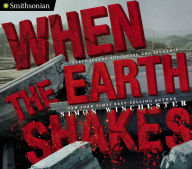How do the ocean currents move? What is a carbon footprint? Why does it rain? Readers are invited on a novelty-packed journey of discovery to find out how the earth works.
Answering a multitude of questions about how our world works, this fun, engaging book introduces the earth’s important cycles and offers an exciting way to learn geography and science. Packed with illustrations and paper fold-outs, flaps, pops, and more to boost interactive learning, HOW THE WORLD WORKS encourages children to think about the impact of human actions on our environment, while engendering respect for the natural world and all its harmonies.
Children's Literature - Eleanor Heldrich
The cover gives an excellent introduction to the kind of book this is going to be. It is 11 inches wide and 10 inches high and colored largely in shades of blue edged in caramel. There are four blue mountains with white tops rising from green earth and blue water. Puffs of white clouds hang over the mountains, five wide red arrows are pointing up, down, and around. In addition to the title of the book, the words "Explore the Earth," "Action packed," "A hands-on guide to our amazing planet," "Flaps to life," "Tabs to pull," "Wheels to turn," "Pull and Amazing pop-ups" are scattered about. All of the inside pages are presented in the same hyper-rich style with lots of images and many patches of words. It opens with the sun, the planets, gravity, night and day, and the seasons. This is followed by "When did life begin?" and "How did life begin?" From there it goes from "Panagea when all the continents were one" to "Moving plates, When plates slide and When plates move apart." The story of the water cycle takes two pages, followed by two pages of weather. Then it jumps from two pages of "Why does the sea move?" to two pages of carbon and the greenhouse effect. The last two spreads deal with "How do plants live?" and "What is a food chain?" To distinguish between subjects there are several different type styles used on each page. There is a little bit of information about a lot of different things, but not enough on any one subject to be fulfilling. Will young readers rush out to get more books to read or will they throw in the towel? Reviewer: Eleanor Heldrich
School Library Journal
Gr 3–5—Limiting its purview to the physical world (alas), this pop-up survey devotes pages or spreads to Earth's history and structure, the origins of life, plate tectonics, the water cycle, weather, ocean currents, the carbon cycle, greenhouse effect, plants, and food chains. In snippets of text tucked into every available nook, Dorion provides commentary ranging from basic information on seasons and other cycles to abbreviated catalogs of cloud types and kinds of boundaries between tectonic plates. Mansfield's special effects are really the strong suit here. In contrast to small, if occasionally lively, painted illustrations and a low-key overall color scheme, the sturdy moving parts offer a stimulating array of movements, from an inset flip booklet showing the continents in motion on one spread and an unusually tall pop-up mountain range rearing up on the next to an array of large pull-out tabs and turn wheels. Far too broadly focused to have much research value, this is nonetheless a worthwhile purchase for its unusual potential in displays and demonstrations.—John Peters, New York Public Library
Kirkus Reviews
This chock-full-of-facts survey of earth and environmental science sets itself an ambitious goal, covering the Big Bang, seasons, the beginnings of life, continental drift, the water cycle, weather, oceanic currents, carbon, the greenhouse effect, photosynthesis and the food chain. It does this in diagram-heavy spreads enhanced with pop-ups and pull-tabs. At their best—as in demonstrating the different types of tectonic plate action and showing, layer by layer, the carbon footprint of a cheeseburger—the movable elements add dramatically to the information conveyed. At worst, they simply provide more surface area to cram facts into. Dizzyingly busy, this exploration provides plenty of information and some naked environmental exhortation ("having a small carbon footprint is much better for the planet than having a big one!"); young eco-browsers will return for multiple readings. (Pop-up nonfiction. 7-11)
Abby McGanney Nolan
…the visual explanations in How the World Works are…wide-ranging and impressive, covering what truly governs our days: sunlight, fresh water, winds and other key components…Although the clear and informative text carries a pro-environment message, it stays clear of preachiness. The facts are what jump out at you.
—The Washington Post
Read More




















